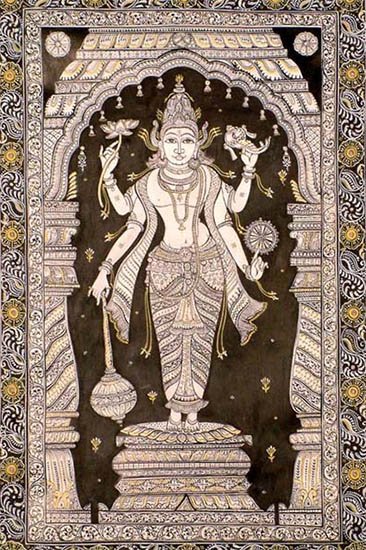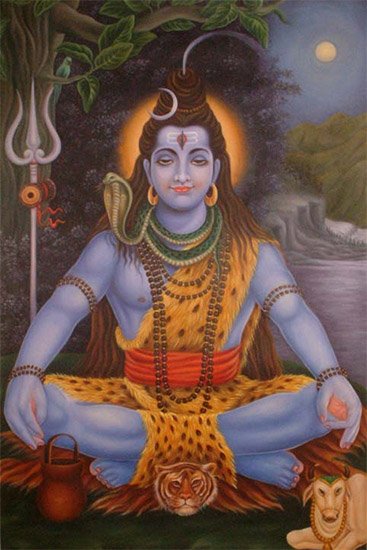Sukhasanamurti, Sukhasana-murti, Sukhāsanamūrti: 3 definitions
Introduction:
Sukhasanamurti means something in Hinduism, Sanskrit. If you want to know the exact meaning, history, etymology or English translation of this term then check out the descriptions on this page. Add your comment or reference to a book if you want to contribute to this summary article.
In Hinduism
Shilpashastra (iconography)
Source: Wisdom Library: Śilpa-śāstraSukhāsanamūrti (सुखासनमूर्ति) refers to an image (mūrti) of an aspect of Śiva. Sukhāsana literally means “pleasant posture”. These type of mūrtis are usually found in most important Śiva temples throughout South-India. The Pūrva-kāraṇāgama states that the figures of Śiva in the sukhāsana-mūrti aspect should not have near them the figure of the Devi. The colour, according to the Kāraṇāgama, of the sukhāsana-mūrti aspect of Śiva is to be coral red.
Source: Google Books: Elements of Hindu iconographySukhāsanamūrti (सुखासनमूर्ति).—(according to the Śilparatna), the image of Sukhāsanamūrti is a seated figure with four arms, three eyes, a very handsome appearance suggestive of the rajoguṇa and of coral red complexion.
Posture: The image should be seated erectly upon a bhadra-pīṭha with its left leg bent and resting upon the seat and the right one hanging below it. It must be clad in the skin of the tiger and also in silk garments.
Hands: In its back right hand is to be the paraśu, and in its back left hand the mṛga; the front right hand should be held in the ahhaya pose, while the front left hand may be either in the varada or the siṃhakarṇa pose.
Ears: In the right ear there should be either a makara-kuṇḍala or a siṃha-kuṇḍala and in the left ear, a patra-kuṇḍala; or there may be vṛtta-kuṇḍalas in both the ears.
Head and Chest: The head is adorned with a jaṭāmakuṭa, the fore-arms with kaṅkaṇas or bracelets shaped like serpents (sarpakaṅkaṇas) and the chest with yajñopavīta; besides these, the image should be decorated with all other ornaments.
It is imperative that neither Devī nor Skanda should be near the Sukhāsanamūrti.

Shilpashastra (शिल्पशास्त्र, śilpaśāstra) represents the ancient Indian science (shastra) of creative arts (shilpa) such as sculpture, iconography and painting. Closely related to Vastushastra (architecture), they often share the same literature.
Shaivism (Shaiva philosophy)
Source: Shodhganga: Iconographical representations of Śiva1) Sukhāsanamūrti (सुखासनमूर्ति) or simply Sukhāsana refers to one of the twenty-three forms (mūrti) of Śiva mentioned in the Pūrvakāmikāgama (pratimālakṣaṇavidhi-paṭala): first and foremost among the Mūlāgama. The forms of Śiva (e.g., Sukhāsana-mūrti) are established through a process known as Sādākhya, described as a five-fold process of creation.
2) Sukhāsanamūrti (सुखआसनमूर्ति) or simply Sukhāsana refers to one of the eighteen forms (mūrti) of Śiva mentioned in the Kāraṇāgama (pratimālakṣaṇavidhi-paṭala): the fourth among the Siddhāntaśaivāgamas. The forms of Śiva (e.g., Sukhaāsana-mūrti) are established through a process known as Sādākhya, described as a five-fold process of creation.
3) Sukhāsanamūrti is also listed among the eight forms (mūrti) of Śiva mentioned in the Rauravāgama: the sixteenth among the Siddhāntaśaivāgamas.
4) Sukhāsanamūrti is also listed among the twelve forms (mūrti) of Śiva mentioned in the Suprabhedāgama (pratimālakṣaṇavidhi-paṭala): the tenth among the Siddhāntaśaivāgamas.
5) Sukhāsanamūrti is also listed among the ten forms (mūrti) of Śiva mentioned in the Ajitāgama (under the Maheśvararūpa heading): the fifth among the Siddhāntaśaivāgamas.
6) Sukhāsanamūrti is also listed among the sixteen forms (mūrti) of Śiva mentioned in the Dīptāgama: the sixth among the Siddhāntaśaivāgamas.
7) Sukhāsanamūrti is also listed among the eighteen forms (mūrti) of Śiva mentioned in the Śilparatna (twenty-second adhyāya): a technical treatise by Śrīkumāra on Śilpaśāstra.

Shaiva (शैव, śaiva) or Shaivism (śaivism) represents a tradition of Hinduism worshiping Shiva as the supreme being. Closely related to Shaktism, Shaiva literature includes a range of scriptures, including Tantras, while the root of this tradition may be traced back to the ancient Vedas.
See also (Relevant definitions)
Partial matches: Sukhasana, Murti.
Query error!
Relevant text
Search found 3 books and stories containing Sukhasanamurti, Sukhasana-murti, Sukhāsana-mūrti, Sukhāsanamūrti; (plurals include: Sukhasanamurtis, murtis, mūrtis, Sukhāsanamūrtis). You can also click to the full overview containing English textual excerpts. Below are direct links for the most relevant articles:
Prayogamanjari and Saivagamanibandhana (Study) (by R. Suthashi)
Description of Sukhasana-Murti < [Chapter 4 - Anthropomorphic forms of Shiva in Kerala Tantric works]
Description of Somaskandesvara-Murti < [Chapter 4 - Anthropomorphic forms of Shiva in Kerala Tantric works]
Kashyapa Shilpa-shastra (study) (by K. Vidyuta)
7. Favourable Directions for Installing the Śiva Mūrtis < [Chapter 3 - Prākāra Lakṣaṇa]
The Religion and Philosophy of Tevaram (Thevaram) (by M. A. Dorai Rangaswamy)
Chapter 1.3 - Umabhaga-murti (depiction of the Mother Goddess) < [Volume 2 - Nampi Arurar and Mythology]